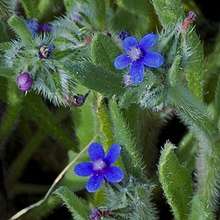Hormuzakia aggregata
Hormuzakia aggregata (Arabic: لسان الثور, Hebrew: לשון-שור מגובבת) is a flowering annual plant in the Borage family, known by the common name massed alkanet.[1][2][3]
| Massed alkanet | |
|---|---|
 | |
| Massed Alkanet flowers in Israel | |
| Scientific classification | |
| Kingdom: | |
| (unranked): | |
| (unranked): | |
| (unranked): | |
| Order: | (unplaced) |
| Family: | |
| Genus: | Hormuzakia |
| Species: | H. aggregata |
| Binomial name | |
| Hormuzakia aggregata Lehm. Gusuleac | |
| Synonyms | |
| |
Description
It is a short-lived herbaceous plant with 10 to 50 cm (3.9 to 19.7 in) ascending hispid stems. The entire leaves are alternate, linear-lanceolate. It flowers from January to April, the small flowers are dark blue to violet producing 3 by 4 mm (0.12 by 0.16 in) hemispherical nutlets.[2]
Taxonomy
The species name Hormuzakia derives from Constantin Freiherr von Hormuzaki a prominent Austro-Romanian naturalist. Anchusa derives from the Greek: αγχουσα, a plant used as a rouge. The epithet aggregata, derives from Latin and means to bring together or cluster.
- The standard author abbreviation Lehm. is used to indicate Johann Georg Christian Lehmann (1792 – 1860), a German botanist.
- The standard author abbreviation Gusul. is used to indicate Mikail Gusuleac (1887-1960), a Romanian botanist.[2]
Distribution and habitat
It grows in Mediterranean woodlands, shrublands, shrub-steppes and deserts of Sicily, North East Egypt and the Sinai Peninsula, Libya, Algeria, Turkey, Cyprus, Lebanon, Israel, Rhodes, Saudi Arabia and the East Aegean Islands.[1][4]
Uses
The roots of Hormuzakia aggregata contain anchusin or alkannin (alkanet red), a red-brown resinoid pigment.[2][5] Alkannin is an antioxidant and has an antimicrobial effect against Staphylococcus aureus and Staphylococcus epidermidis. It is also known to have wound healing, antitumor, and antithrombotic properties.[6]
Alkannin is also found in the Chinese herbal medicine plant Lithospermum erythrorhizon, the red-root gromwell. The dried root is a Chinese herbal medicine with various antiviral and biological activities, including inhibition of human immunodeficiency virus type 1 (HIV-1).[7][8][9]
References
- "Catalogue of Life : Hormuzakia aggregata (Lehm.) Gusuleac". www.catalogueoflife.org. Retrieved 2017-05-10.
- "Anchusa aggregata". www.flowersinisrael.com. Retrieved 2017-05-10.
- SELVI, F.; BIGAZZI, M. (1998-01-01). "Anchusa L. and allied genera (Boraginaceae) in Italy". Plant Biosystems - an International Journal Dealing with All Aspects of Plant Biology. 132 (2): 113–142. doi:10.1080/11263504.1998.10654198. ISSN 1126-3504.
- "Hormuzakia aggregata (Lehm.) Gusuleac | Flora of Israel Online". Flora of Israel Online. Retrieved 2017-05-10.
- "Alkannin | 517-88-4". www.chemicalbook.com. Retrieved 2017-05-11.
- Vassilios P. Papageorgiou; Andreana N. Assimopoulou; Elias A. Couladouros; David Hepworth; K. C. Nicolaou (1999). "The Chemistry and Biology of Alkannin, Shikonin, and Related Naphthazarin Natural Products". Angew. Chem. Int. Ed. 38 (3): 270–300. doi:10.1002/(SICI)1521-3773(19990201)38:3<270::AID-ANIE270>3.0.CO;2-0.
- Chen, X (Sep 2003). "Shikonin, a component of chinese herbal medicine, inhibits chemokine receptor function and suppresses human immunodeficiency virus type 1". Antimicrob Agents Chemother. 47 (9): 2810–6. doi:10.1128/aac.47.9.2810-2816.2003. PMC 182643. PMID 12936978.
- Gao, H.; et al. (2011). "Anti-adenovirus activities of shikonin, a component of Chinese herbal medicine in vitro". Biol Pharm Bull. 34 (2): 197–202. doi:10.1248/bpb.34.197. PMID 21415527.
- Chen, J; Xie, J; Jiang, Z; Wang, B; Wang, Y; Hu, X (2011). "Shikonin and its analogs inhibit cancer cell glycolysis by targeting tumor pyruvate kinase-M2". Oncogene. 30 (42): 4297–4306. doi:10.1038/onc.2011.137. PMID 21516121.